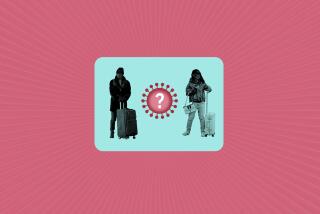Insurance Can Ease Health Crisis on Road
- Share via
Despite all the bad press the U.S. health-care system receives, most Americans take for granted that quality medical care in an emergency is usually as close as the nearest hospital.
But imagine being on a business trip overseas when a medical emergency arises. Would you know what to do?
Even if your company-provided or self-insured health benefits include business travel coverage, your employer may not have a program in place to help you get care in a foreign country.
A sick or injured business traveler may end up learning the hard way that a hospital abroad refuses treatment until being paid upfront in cash and won’t accept Blue Cross or any other U.S.-based health coverage.
But a health problem doesn’t have to be a crisis if you have adequate insurance protection. Consider the case of an American employee of a multinational company who earlier this month was on a business trip in East Africa when he was critically injured in a car accident.
The businessman, who had internal injuries, was taken to the nearest hospital. But it was quickly determined that his condition would require sophisticated treatment unavailable where he was, 200 miles from the nearest big city.
Once he was stabilized, he was transported over land to a larger city and was admitted to a bigger medical facility. But even there it became clear he would not be able to receive the care necessary to save his life. Within hours, he was boarded on a private air ambulance and evacuated to London.
What would have been a logistical nightmare to conduct on his own was a relatively easy task because his employer had contracted with an international assistance provider, or IAP. The injured man needed only to make one call at the onset of the incident to receive consultation from an English-speaking physician, who evaluated his situation and eventually determined he needed to get out of the country altogether. And the company’s IAP plan covered all costs, which exceeded $20,000.
*
Many insurers and IAPs, recognizing the growing ranks of small-business and independent business travelers, offer individual policies as well as corporate programs. Such policies, including emergency evacuation and, in some cases, up to $1 million in medical coverage, cost from $50 for two weeks of coverage to as much as $800 per person per year. Once enrolled, a member will receive a card with 24-hour numbers of the IAP’s crisis centers.
“It’s a secret little industry,” said John Knapp, vice president of marketing for International SOS, a Philadelphia-based IAP with 1,400 corporate clients worldwide. But the number of international business travelers is continuing to rise. In 1998, about 1.4 million Americans took at least one overseas business trip, according to the Travel Industry Assn. of America.
“In a single year, a multinational company may have one or two major evacuations, but even so, they need to be able to respond to that,” Knapp said. “It’s very hard for a company to respond without any assistance.”
What IAPs offer is a worldwide network of crisis centers staffed by multilingual health-care professionals who consult with the physician treating the stricken traveler and determine whether the traveler should be moved to a different facility or evacuated.
“A business traveler may be in Saudi Arabia or Russia and if something happens . . . he needs to be able to reach someone to help him if he needs to get home,” said Bob Chambers, vice president of market for CSA Travel Protection, a travel insurance provider based in San Diego. “They’re buying that expertise.”
*
But while most Fortune 500 companies are likely to provide such travel gap medical assistance benefits, other firms may not; or if they do, they may not adequately brief employees about them.
Independent insurance broker Leslie Saunders recently commissioned a survey of 100 U.S. corporate travel managers and found that more than a third did not have policies for handling overseas travel emergencies. “Frankly, we were very surprised by the results,” said Saunders, president of Leslie Saunders Insurance & Marketing International in Tampa, Fla.
It’s in companies’ best interest to provide their employees with an overseas assistance program, to prevent an emergency situation in a foreign country from becoming a corporate liability.
The IAPs offer themselves up as the conduits for briefing business travelers on what they need to know to help prevent emergencies before heading off.
“Most companies do not sit down with their employees before every trip and evaluate what they need to know to prepare themselves,” Knapp said. His company offers an array of pre-travel guidance, including a members-only Web site that will figure what inoculations are needed for travel to a particular country, if there are safety issues to consider and what medical facilities are available in the major cities should one be needed.
Traffic accidents are the third-most common reasons that travelers will call seeking help, according to Knapp. Travelers’ diarrhea and respiratory problems are the No. 1 and No. 2 issues.
“Sometimes it’s just a comfort to talk to a physician on the phone,” he said. “If someone is on a $20,000 business-class trip to Asia and Africa and two stops into it gets travelers’ diarrhea, without any resources they may just cancel the trip. We help them continue on their trip.”
*
The Times is interested in hearing about your experiences as a business traveler and as someone doing business in the international marketplace. Please contact us at global.savvy@latimes.com.
(BEGIN TEXT OF INFOBOX / INFOGRAPHIC)
Issues to consider before traveling overseas:
* Get appropriate immunizations and preventive medications.
* Obtain address and phone number of the U.S. Embassy or Consulate in each country you visit. (See the State Department Web site: https://travel.state.gov ) .
* Ascertain whether your health insurance covers illness abroad.
* Carry adequate supplies of all required medications (including syringes, if needed).
* Take an extra pair of eyeglasses or lenses and lens solution, and your optical prescription.
* Pack a basic first aid kit.
Source: CSA Travel Protection
More to Read
Sign up for Essential California
The most important California stories and recommendations in your inbox every morning.
You may occasionally receive promotional content from the Los Angeles Times.













